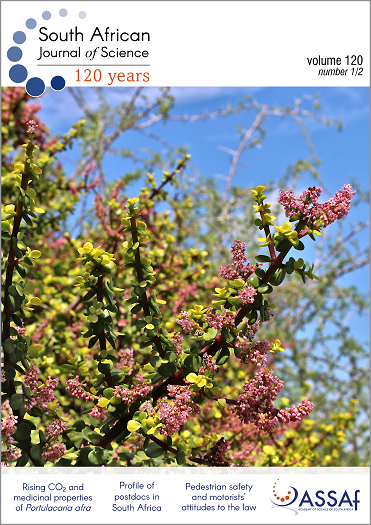Use of sulfur dioxide to reduce postharvest decay and preserve the quality of fresh tomatoes
DOI:
https://doi.org/10.17159/sajs.2024/16626Keywords:
sulfur dioxide, Roma tomatoes, Rosa tomatoes, Round tomatoes, postharvest decayAbstract
Tomatoes are an important and versatile crop with a short shelf life. Postharvest losses due to fruit decay and handling are reportedly as high as 30–50% globally; therefore, the agricultural sector would benefit from solutions that target the preservation of crops such as tomatoes. In this study, we investigated the potential use of sulfur dioxide (SO2) to provide postharvest protection against fungal decay in tomatoes whilst maintaining the quality of tomato fruit. Three tomato varieties packed as bulk (3–5 kg) cartons were exposed to SO2-generating sheets applied as either a top sheet over the fruit or a bottom sheet placed on the base of the carton before packing the fruit on the top. The results show that the application of SO2-generating sheets reduced the natural progression of decay on ‘Roma’ tomatoes by up to 60% and up to 80% on ‘Rosa’ tomatoes. Only marginal decay control was observed on ‘Round’ tomatoes. The top sheet application rendered the best results, as the application of the bottom sheet resulted in phytotoxicity in the form of SO2 damage. SO2 application reduced fruit shrivelling, especially when tomatoes were stored at higher temperatures during their shelf life. The application of SO2 on the tomatoes did not have any negative effects on fruit firmness. The results of this study provide a case to further explore the use of SO2-generating sheets on tomatoes to prevent postharvest decay. Differences in varietal physiology may be key to the successful application of this technology.
Significance:
Tomatoes are a crop that is highly susceptible to postharvest decay. These effects lie mainly with the end consumer. Besides the monetary loss of buying a commodity that rots quickly, pathogens infecting tomatoes are known to produce mycotoxins that pose a risk to human health. With food availability and safety concerns, the application of a product that could reduce these concerns would be beneficial to the agricultural sector.
Published
Issue
Section
License

All articles are published under a Creative Commons Attribution 4.0 International Licence
Copyright is retained by the authors. Readers are welcome to reproduce, share and adapt the content without permission provided the source is attributed.
Disclaimer: The publisher and editors accept no responsibility for statements made by the authors
How to Cite
- Abstract 404
- PDF 1013
- EPUB 352
- XML 376












.png)